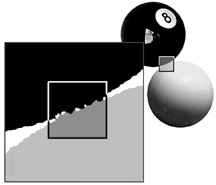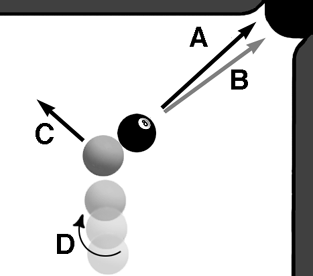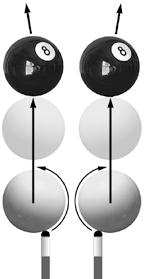Aiming II -Throw
| by Jim Meador
Dedication
This article is dedicated to "Cuemaker", cuemaker@televar.com, who insisted that I advise the use of side spin to compensate for throw. We don't agree on when to introduce side spin to beginners, but he made a compelling case, and I do respect his knowledge of the game. Rather than introduce the effects of throw in the "Aiming" article, I handle it as a separate issue here. Thanks for pressing the issue Cuemaker, whoever you are.
Beginners Notice
I believe beginners should read and practice the advice given in the article "Aiming" before trying to digest this information. If, after reading it, you believe you are missing shots that are hit correctly, it is possible that throw is the culprit. This article covers the effects of throw. But, be advised that outside spin, the most common cure for throw, may be harder to deal with than the cause of throw.
I believe it is best to learn to stroke with a center cue hit, aiming at a point where an imaginary line from the center of the pocket exits through the opposite side object ball . When beginners learn to make shots consistently with center cue hits, they are actually causing the cue ball to hit the object ball a little thinner than they realize, or instructed. But the difference is so slight that it appears that the actual aiming point was hit precisely. This is one of those cases where perception of fact has an advantage. Student faithfully follow instructions and, with practice, starts sinking balls, unaware that they are "cheating." So why allow them to believe something that isn't exactly true?
Sometimes a little white lie is much less daunting than the truth. I have a seven year old grandson (Dee Meador) who competes in an adult league. He has bested some good adult players, and he can barely see over the table. He has developed his own method of aiming and stroking that compensates for his "vertically challenged" view. He faces many of the same problems that wheelchair competitors face, but with the added challenge of shorter arms. Being seven years old is probably an advantage mentally. As he grows taller, he will adjust automatically to a changing perspective of the table. I would not presume to know better than he about his own changing world. Everyone has their own, unique handicap that requires subtle to extreme adjustments. I am old, lecherous, half blind, I have a bum ticker, and I am romantically snookered behind a fruitcake named Pat "The Surgeon" Stokes.
 Directional
Throw
Directional
Throw
Although pool balls feel very smooth to human touch, under a microscope their surfaces will appear pitted and rough. It is rough enough, in fact, to cause friction between balls when they come into contact with each other. The illustration at left simulates a microscopic view.
When the cue ball comes into contact with an object ball, there
is a millisecond of time where they "stick" together because of the
friction between their surfaces. The cue ball, during that brief
moment of impact, will push the object ball ahead of it before the
object ball "bounces" off slightly ahead of the intended path. The
anomaly is called "directional throw because it appears that the
object ball is thrown slightly ahead of the intended path.
It is possible to compensate for directional throw by using slight outside spin on the cue ball. Outside spin causes the cue ball to "roll" off the surface of the object ball, thereby reducing, or eliminating the friction between their surfaces.
Path "A" in the illustration at right, is the throw path a ball might take if the aiming point is hit precisely without spin. Path "B" is the adjusted path with compensating left spin on the cue ball. "D" represents the cue ball approaching with left spin, and "C" is the approximate deflection path of the cue ball with no spin.
The reason I hesitate advising side spin to compensate for throw, is that the technique is seriously vulnerable to cue ball squirt and curve. A beginner often has trouble hitting the cue ball accurately with the tip of the cue stick. Just a little bottom or top, in combination with side spin, can cause the cue ball to diverge off the intended path. Additionally, trying side spin could affect the way the shot is sighted. It does little good for a student to solve one problem if a greater is created.
Most advanced players subconsciously use "anti-throw" side spin. They also know that side spin affects the deflection of the cue ball from the object ball, and it's rebound action off the rail. The ancillary action of the cue ball, when using side spin to compensate for throw, is an entirely different subject that can not be covered here. Just be aware of the fact, and watch the cue ball very carefully when you start using side spin to reduce throw. This need to be observant after you pull the trigger is one of the reasons you should keep your head down over the table after stroking.
 Spin
Throw
Spin
Throw
There are two types of throw. One, directional throw, was covered above as an anomaly that had to be adjusted for by using side spin to reduce friction. Oddly enough, the second type, "spin throw", uses side spin to exaggerate friction in order to throw a ball in a desired direction.
At far left, the eight ball is thrown left, using right spin. The second diagram shows the eight ball thrown right, using left spin. The throw friction between the balls is created by the spin on the cue ball which "throws" the object ball in the direction of the spin.
Often, if I am faced with a shot that requires a hit on the object ball that is almost full, I will use spin throw in lieu of cutting the ball. Throw also allows me to be more creative with positioning. Moreover, it is a great dynamic for banking, since throw spin transfers the opposite spin (slightly) to the object ball. Most advanced players use throw excessively, especially when they are in stroke and shooting "fast and loose." Volumes have been written about throw. It is one of the most exciting dynamics of the game. It is also among the most treacherous.
Happy Shooting, Jim
Most Popular
Jackass Shooting Pool
Syndrome
Physics of Pool
Bumper Pool
The Masse'
Snooker
Topless Sharking
Selecting a Cue Stick
Long and Straight
Trick Shots
Aiming
Advertisement







